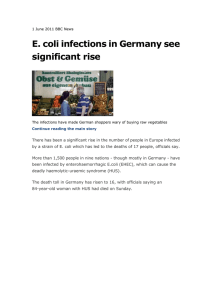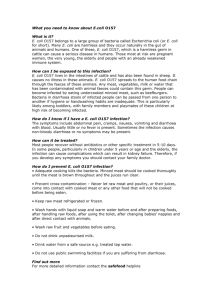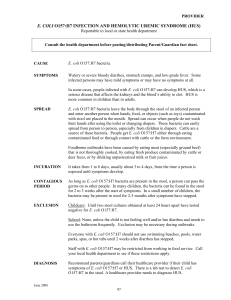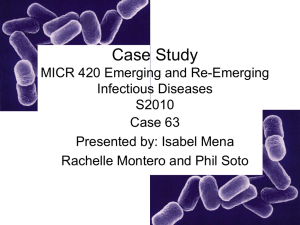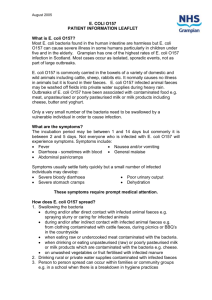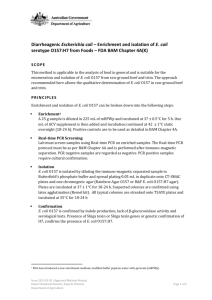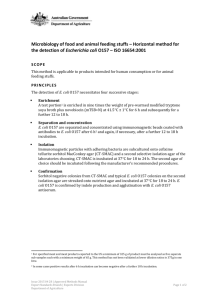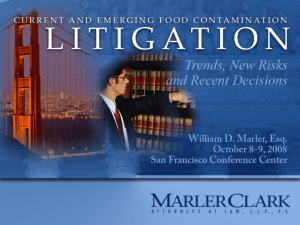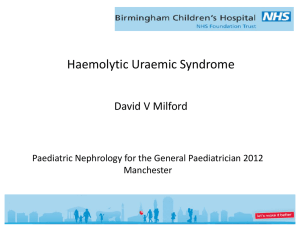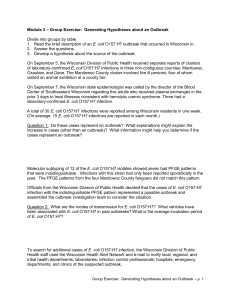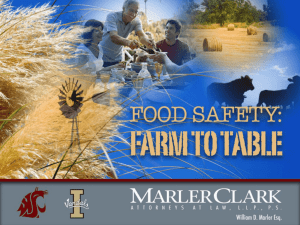e. coli 0157 - lamsam
advertisement
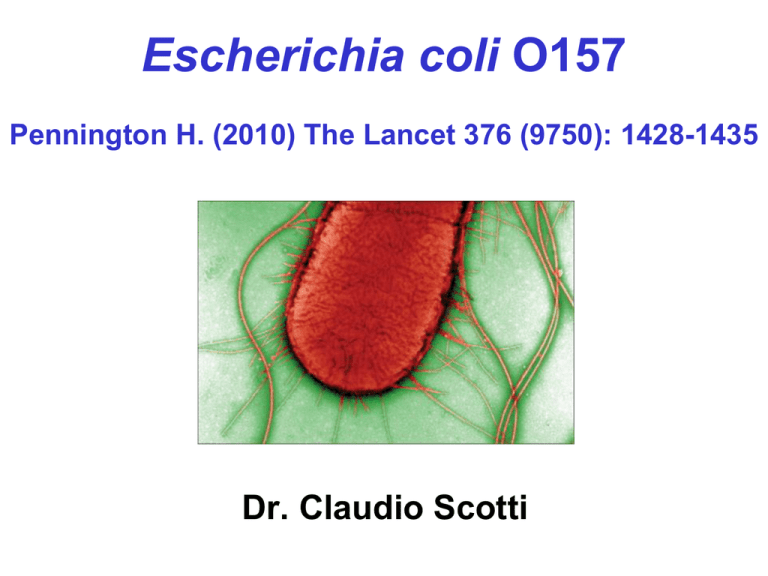
Escherichia coli O157 Pennington H. (2010) The Lancet 376 (9750): 1428-1435 Dr. Claudio Scotti GI tract infections in the UK • • • • • • • • Campylobacter Rotavirus Salmonella Norovirus Cryptosporidium Giardia Shigella Escherichia coli O157 Escherichia coli • Six different groups of pathogenic E. coli: - EPEC: enteropathogenic - ETEC: enterotoxigenic - EHEC: enterohaemorrhagic (VTEC) - EIEC: enteroinvasive - EAEC: enteroaggregative - DAEC: diffuse-aggregative E. coli O157 in England & Wales MONTH 2000 2001 2002 2003 2004 2005 2006 2007 2008 2009 JAN FEB MAR APR MAY JUN JUL AUG SEP OCT NOV DEC 19 14 32 43 94 110 134 111 176 119 25 19 23 25 25 24 49 88 107 127 118 81 68 33 15 13 27 24 49 46 79 114 92 58 53 25 12 13 19 27 44 61 94 154 152 60 28 11 9 18 23 34 56 78 91 144 129 62 33 22 17 16 22 38 61 96 129 109 182 123 125 32 21 24 37 27 71 111 234 160 124 113 57 22 27 23 17 36 118 83 145 125 86 70 66 32 32 27 28 68 101 106 105 122 210 76 48 27 24 11 29 43 56 126 145 137 230 107 89 37 TOTAL 896 768 595 675 699 950 1001 828 950 1034 Typical features • Abdominal pain • Five or more bowel movements in the day before presentation • Non-bloody diarrhoea, becoming bloody after 1-4 days • No fever • 10-15% of patients develop haemolytic uraemic syndrome (HUS) 5-13 days after the onset of diarrhoea Haemolytic uraemic syndrome • Acute onset of renal impairment with oliguria or anuria and high concentrations of serum urea and creatinine • Platelet counts less than 15x109 cells/L • Microangiopathic haemolytic anaemia with haemoglobin <10 g/dL and with fragmented red cells in a peripheral blood smear The first oubreak • 1982, in Oregon and Michigan, USA • Bloody diarrhoea and severe abdominal cramps after eating hamburgers in a restaurant chain • First outbreak in the UK: 1983 The largest outbreak • Sakai City, Japan, in 1996 • Associated with white radish sprouts served as school meals • 7,966 cases • 2,764 microbiologically confirmed • 106 with haemolytic uraemic syndrome (HUS) The source of E. coli O157 • Ruminants, particularly cattle (prevalence between 0.2 and 48.8%) and sheep • 80% of transmission arise from the 20% of animals that are most infectious (supershedders) • Secondary spread (20% of outbreak cases) Transmission of E. coli O157 Transmission of E. coli O157 Source of transmission Food Dairy products Animal contact Water Environmental Unknown Outbreaks 42.2% 12.2% 7.8% 6.7% 2.2% 28.9% Transmission of E. coli O157 • Quantitative microbial risk assessment showed that the risk is 100 times greater for visits to pastures than for consumption of burgers in the northeast of Scotland • Heavy rain is frequently associated with outbreaks (e.g. Glastonbury festival in 1997) Isolation rates, UK 1984-2008 Incidence of infection • Per 100,000: – 4.7 in Scotland – 4 in Canada – 2.87 in Ireland – 2.74 in Japan – 2.1 in England and Wales – 1.3 in the USA – 0.43 in Germany – 0.08 in France Disease caused by E. coli O157 • 1996, in central Scotland, associated with meat from a butcher: 279 individuals, 17 people died from the direct effects of infection • Irish outbreak, water-borne spread: 18 individuals, 2 children with HUS • 2010 English outbreak on an open farm: 17 developed HUS (8 of them receiving dialysis) Typical features • HUS is most common in children younger than 5 years • In England and Scotland, between 1997 and 2001, 226 (65%) of the 350 cases occurred in this age group • Once an infection has been established, no therapeutic interventions are available to lessen the risk of the development of the HUS Outcomes of HUS Outcome Received peritoneal dialysis, haemodialysis, or haemofiltration Recovered and were released Renal impairment Became dependent on dialysis Had neurological impairment Died 53% 48% 13% 7% 4% 4% Extrarenal effects • Increase in pancreatic enzymes and oedema • Necrosis of the colon wall • Myocardial damage • CNS damage (25% of cases), with seizures, paralysis, coma • Deaths are usually associated with severe extra-renal complications Virulence factors • Two different Shiga toxins (Stx1, Stx2) • Correlation with bloody diarrhoea and HUS • Shiga toxin binds to glycosphingolipid globotriaosylceramide (Gb3), a cell surface receptor • In the human kidney, Gb3 is present on glomerular endothelial cell types and various tubular epithelial cell types Virulence factors • Enterocyte effacement genes: mediate the intimate attachment of bacteria to the intestinal epithelium • Several plasmid-encoded genes promoting adherence • Upregulation of flagellar and chemotaxis genes Prevention (failure points) • Failure during or after milk pasteurisation • Rare and light cooking of hamburger patties • Failure in municipal water chlorination • Failure to prevent cross-contamination or ready-to-eat foods by direct or indirect contact with raw meat • Handwashing Conclusion • Ground beef outbreaks still occur in the USA but are now associated with homemade burgers • A vaccine that shows promise has been developed • Investigation of “supershedders” (> reduction of ruminant carriage)
